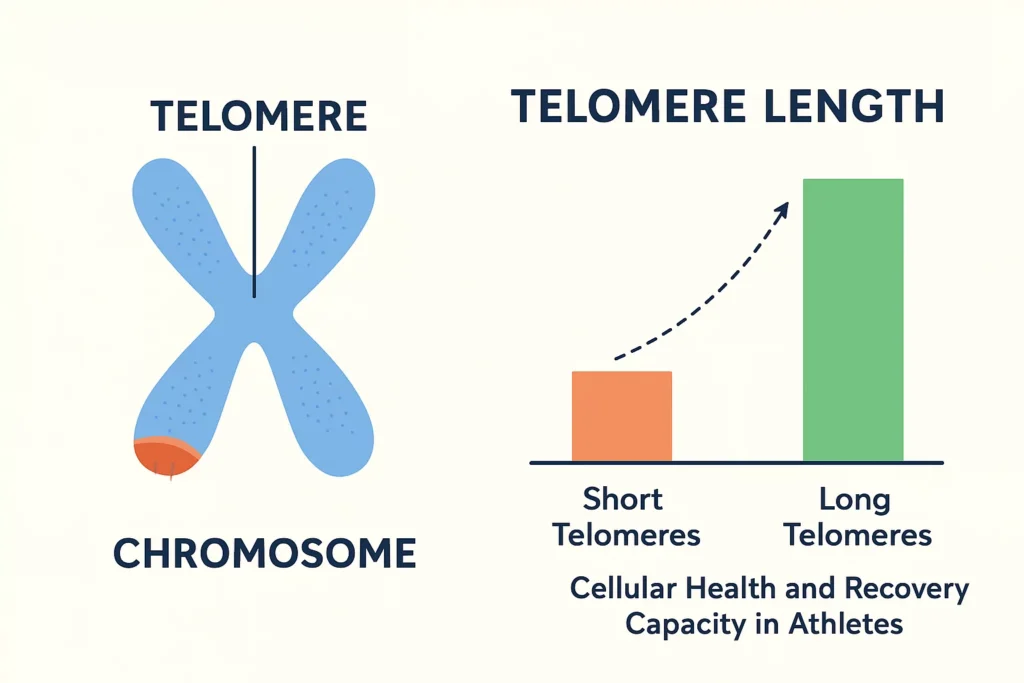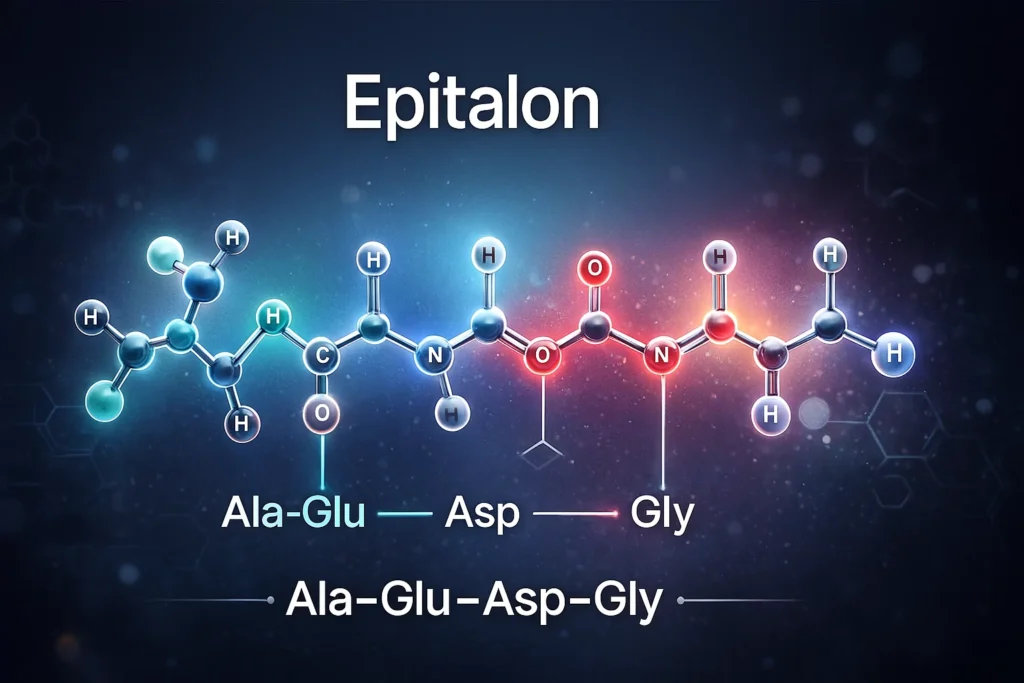Welcome to the frontier of performance enhancement, where the battle for gains is moving from the gym floor to the cellular level. This article explores Epitalon, a researched tetrapeptide that may support telomerase activation, not as a fountain of youth, but as a potential tool for enhancing cellular resilience, accelerating recovery, and extending an athlete’s prime.
The Cellular Arena: Telomeres, Telomerase, and Athletic Performance
What Are Telomeres? (The Body’s “Training Log”)
Imagine telomeres as the protective plastic tips on your shoelaces—but for your chromosomes. These repetitive DNA sequences cap the ends of your chromosomes, protecting your genetic data during cell division. Every time a cell divides, these telomeres get slightly shorter. When they become too short, the cell can no longer divide and becomes senescent (dormant) or dies.
For athletes, this process is accelerated. Intense training creates oxidative stress and inflammation, which can speed up telomere shortening. The National Institute on Aging recognizes shortened telomeres as a marker of biological aging and increased disease risk.
Telomerase: The Enzyme of Cellular “Resets”
Telomerase is the enzyme that can rebuild and maintain telomere length. Think of it as a cellular maintenance crew that can add back the lost segments. Unfortunately, telomerase activity naturally declines with age and chronic stress—two factors that affect even the most dedicated athletes.
Why Should an Athlete Care? The Performance Connection
This isn’t just abstract science—it has direct implications for your performance:
- Recovery: Cells with healthy telomeres replicate more efficiently, crucial for repairing muscle tissue between sessions
- Injury Resilience: Healthy cells maintain stronger connective tissue (tendons, ligaments)
- Systemic Health: Impacts immune function (fewer sick days), cognitive sharpness (focus during training), and overall vitality

Introducing Epitalon – The Pineal Peptide
What is Epitalon?
Epitalon is a synthetic tetrapeptide (composed of four amino acids: Ala-Glu-Asp-Gly) modeled after the natural pineal peptide Epithalamin. It’s important to clarify its status: this is a research chemical, not an FDA-approved drug. It is typically administered via subcutaneous injection in research settings.
Unlike many performance-enhancing compounds that work on immediate pathways, Epitalon operates at the genetic level, potentially influencing how your cells age and function. For those interested in other peptide approaches, our guide on Why Athletes Are Turning to Peptides for Injury Recovery explores additional options.
The Proposed Mechanism: More Than Just Telomerase
While telomerase activation gets the headlines, Epitalon’s potential benefits for athletes may extend beyond this single mechanism:
- Primary Mechanism: Gene expression regulation. Epitalon is believed to activate the hTERT gene, which codes for the catalytic subunit of telomerase
- Epithalamium Optimization: Normalizing production of melatonin and cortisol, leading to improved deep sleep and better stress adaptation
- Antioxidant Effects: Reducing the oxidative damage that intense training inflicts on cells
- Cell Cycle Regulation: Promoting healthy apoptosis (cell death) of senescent “zombie” cells that contribute to inflammation

The Evidence – What Does the Research Really Say?
Pre-Clinical and In-Vitro Studies
Laboratory research has shown promising results. A landmark study published in Aging Research Reviews demonstrated that Epitalon could extend telomere length in human cell cultures. Animal studies, particularly on mice, have indicated not just lifespan extension but improved physiological markers relevant to athletes—better stress response, maintained physical function, and delayed onset of age-related conditions.
The Athletic Data Gap (A Section of Honesty)
Here’s where we must be perfectly transparent: no large-scale, double-blind, placebo-controlled human trials exist specifically on elite athletes. The existing evidence comes primarily from animal models, cell studies, and limited human trials focused on general aging.
However, we can bridge this gap by examining how the known mechanisms (recovery, reduced inflammation, improved sleep) directly translate to athletic goals. The improved mitochondrial function discussed in our article on NAD+ for Athletes shares some overlapping pathways with Epitalon’s proposed benefits.
The Practical Protocol – A Bodybuilder’s Guide to Epitalon
Sourcing and Purity: Navigating the Unregulated Market
This cannot be overstated: in an unregulated market, purity is paramount. The difference between legitimate research compounds and under-dosed or contaminated products is substantial. Always look for third-party testing verification (HPLC/MS) from reputable suppliers. Finding real Epitalon from Peptide Hubs with verified purity should be a non-negotiable requirement.
Cycling Strategy: The “Cellular Reset” Protocol
Based on existing research protocols, a common approach involves:
- Standard Cycle: 5-10mg administered subcutaneously daily
- Duration: 10-20 day cycles
- Frequency: 1-2 times per year, as effects are believed to be long-lasting
- Timing: Evening administration to synergize with natural pineal rhythms
Stacking Synergies
Epitalon may be complemented with other evidence-based supplements:
- For Sleep & Recovery: Magnesium Glycinate, Apigenin
- For NAD+ Support: Niacinamide (as discussed in our NAD+ guide)
- For Mitochondrial Health: Similar to mechanisms explored in our L-Carnitine article

Weighing the Scales – A Realistic Risk/Benefit Analysis
Potential Benefits for the Lifter & Athlete
Based on research and anecdotal reports, potential benefits may include:
- Deeper, more restorative sleep (critical for growth hormone release)
- Noticeably improved recovery between intense sessions
- Reduced joint pain and improved connective tissue integrity
- Subjective “feeling of vitality” and well-being
- Potential long-term cellular health support
The Risks and Unknowns
No compound is without potential concerns:
- The Cancer Question: The theoretical concern that telomerase activation could fuel pre-existing cancer cells. Research is complex here—some studies suggest Epitalon may actually promote healthy cell cycle regulation rather than encouraging malignancy
- Lack of Long-Term Human Data: The biggest unknown remains the long-term effects in healthy humans using Epitalon specifically for performance enhancement
- Side Effects: Generally considered minimal but may include injection site irritation, transient headaches, or sleep disturbances if dosed incorrectly
As with any advanced supplementation strategy, understanding the risk profile is essential. Other peptides like AOD 9604 or GHRP-2 have different mechanisms and risk profiles worth comparing.
Conclusion: The Future of Performance Enhancement?
Epitalon represents a fascinating frontier in biohacking, moving beyond acute performance boosts to target the very foundation of cellular health and longevity. This isn’t about getting stronger for your next workout—it’s about maintaining peak performance capacity for years to come.
The final verdict: Epitalon is not a magic bullet but a sophisticated, potential tool for the serious athlete who has optimized all other variables and is willing to navigate the uncertainties of cutting-edge science. The pursuit of peak performance is evolving from the gym to the cellular level.
Before considering a compound like Epitalon, prioritize the fundamentals: periodized training, impeccable nutrition, and stress management. For those who have mastered these, the science of telomerase activation may just be the next frontier worth exploring.

